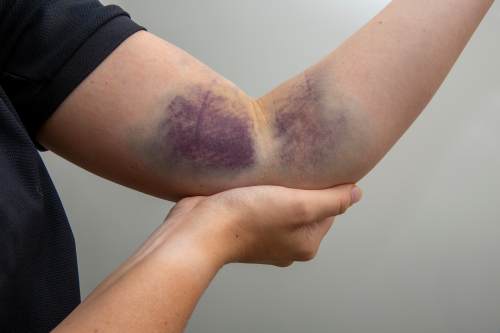Blunt Trauma Injury Lawyers in Illinois
5-Star Rated Illinois Accident Lawyers for Victims of Blunt Trauma Injuries from Car Accidents, Slip and Falls, and Motorcycle Crashes
What are Blunt Trauma Injuries?
Blunt trauma injuries are among the most common and severe types of physical harm suffered in accidents, often leading to life-threatening conditions, long-term disabilities, or even fatalities. These injuries occur when a forceful impact causes damage without penetrating the body, affecting organs, bones, and soft tissues. Blunt force trauma can result from motor vehicle accidents, falls, workplace incidents, sports injuries, and violent assaults.
Common Causes of Blunt Trauma Injuries
Blunt trauma injuries arise from a variety of incidents, including:

- Car Accidents
- Car crashes are a leading cause of blunt trauma injuries. According to the National Highway Traffic Safety Administration (NHTSA), in 2021, over 2.1 million people sustained injuries in U.S. traffic accidents, many of which involved blunt force trauma. Victims may suffer from head injuries, broken ribs, and internal bleeding due to the high-impact forces involved in crashes.
- Falls
- The Centers for Disease Control and Prevention (CDC) reports that falls account for over 800,000 hospitalizations annually in the United States, making them a major source of blunt trauma injuries. Elderly individuals are particularly vulnerable, often suffering hip fractures, concussions, or spinal injuries from falls.
- Workplace Accidents
- Employees in construction, manufacturing, and industrial settings frequently sustain blunt trauma injuries due to falling objects, machinery malfunctions, or slips and falls. The Occupational Safety and Health Administration (OSHA) states that workplace injuries related to blunt force trauma contribute to thousands of lost workdays each year.
- Sports and Recreational Activities
- Contact sports like football, boxing, and hockey pose significant risks for blunt trauma injuries, especially concussions and broken bones. The CDC estimates that nearly 3.8 million sports-related concussions occur annually in the U.S.
- Violence and Assault
- Victims of physical assaults often suffer from blunt trauma injuries caused by fists, blunt objects, or other weapons. The Bureau of Justice Statistics indicates that over 600,000 cases of aggravated assault occur each year in the United States, with many victims experiencing severe trauma to the head and torso.
Symptoms of Blunt Trauma
The symptoms of a blunt trauma injury can vary widely depending on the area of the body affected and the severity of the impact. Some common symptoms include:
- Head and Brain Trauma
- Loss of consciousness or confusion
- Headaches and dizziness
- Nausea or vomiting
- Blurred vision or sensitivity to light
- Memory loss or difficulty concentrating
- Chest and Abdominal Trauma
- Difficulty breathing or shortness of breath
- Chest pain or tightness
- Internal bleeding symptoms such as dizziness, fainting, or abdominal swelling
- Tenderness or bruising in the chest or abdominal region
- Bone and Soft Tissue Injuries
- Swelling, bruising, or deformity around the injured area
- Severe pain or difficulty moving the affected limb
- Numbness or tingling, indicating possible nerve damage
- Muscle weakness or instability
- Spinal Cord Injuries
- Loss of sensation or movement in limbs
- Intense back or neck pain
- Difficulty with coordination or balance
- Loss of bladder or bowel control in severe cases
It is essential to seek immediate medical attention if any of these symptoms arise after an accident, as untreated blunt trauma injuries can lead to severe complications or even death.
Types of Blunt Trauma Injuries
Blunt trauma injuries vary in severity, ranging from minor contusions to life-threatening internal damage. Some of the most common types include:
- Head and Brain Injuries
- Traumatic brain injuries (TBI) are a major consequence of blunt force trauma. The CDC reports that in 2020, there were approximately 223,135 TBI-related hospitalizations in the U.S. Symptoms range from mild concussions to severe cognitive impairment or coma.
- Chest and Abdominal Injuries
- Blunt force to the chest can lead to broken ribs, collapsed lungs (pneumothorax), or cardiac contusions. Abdominal trauma may cause internal bleeding, ruptured organs, or bowel perforation, often requiring emergency surgery.
- Bone Fractures
- High-impact forces frequently cause fractures in the arms, legs, pelvis, and spine. Severe cases may involve compound fractures or crushing injuries that necessitate surgical intervention.
- Soft Tissue Damage
- Muscles, ligaments, and tendons can suffer from contusions, sprains, or deep tissue damage due to blunt trauma. These injuries can result in chronic pain and mobility issues.
- Spinal Cord Injuries
- Spinal trauma can lead to temporary or permanent paralysis, depending on the severity of the injury. The National Spinal Cord Injury Statistical Center estimates that approximately 18,000 new spinal cord injury cases occur each year in the U.S.
Medical Treatment and Recovery
Blunt trauma injuries often require extensive medical intervention, including:
- Emergency Care: Immediate assessment and stabilization are critical, especially in cases involving head trauma, internal bleeding, or spinal injuries.
- Diagnostic Imaging: X-rays, CT scans, and MRIs are commonly used to assess the extent of internal damage.
- Surgical Procedures: Severe injuries may require surgery, such as repairing organ damage, setting fractures, or decompressing brain swelling.
- Physical Therapy: Long-term rehabilitation is often necessary for individuals recovering from severe blunt trauma injuries.
Legal Recourse for Victims of Blunt Trauma Accidents
Victims of blunt trauma injuries may have legal recourse if the injury was caused by another party’s negligence. Key legal aspects include:
- Liability and Negligence
- Proving negligence is essential in personal injury claims. For instance, a driver violating traffic laws, an employer failing to provide safety measures, or a property owner neglecting hazardous conditions on their property can be held liable.
- Compensation for Damages
- Victims with blunt trauma injuries can seek compensation for:
- Medical expenses (hospital stays, surgeries, rehabilitation)
- Lost wages and future earning capacity
- Pain and suffering
- Permanent disability or disfigurement
- Wrongful death (if the injury resulted in fatality)
- Victims with blunt trauma injuries can seek compensation for:
- Statute of Limitations in Illinois
- In Illinois, the statute of limitations for personal injury cases is generally two years from the date of the injury (735 ILCS 5/13-202). However, exceptions may apply, such as cases involving minors or against government entities.
- Role of Personal Injury Attorneys
- An experienced personal injury attorney can help victims gather evidence, negotiate with insurance companies, and pursue legal action to obtain fair compensation.
Contact the Award-Winning Trauma Injury Lawyers at John J. Malm & Associates
Blunt trauma injuries are a significant public health concern, often leading to devastating physical, emotional, and financial consequences. Whether caused by car accidents, falls, workplace incidents, or violence, these injuries can severely impact victims’ lives. Legal recourse is often necessary for those injured due to negligence, to ensure they receive the compensation needed for recovery.
If you or a loved one suffered a blunt trauma injury in an accident, contact John J. Malm & Associates for a free consultation. Our top-rated Illinois trauma injury attorneys have over 90 years of combined experience helping victims of serious accidents. Let us help you get the compensation you deserve.








